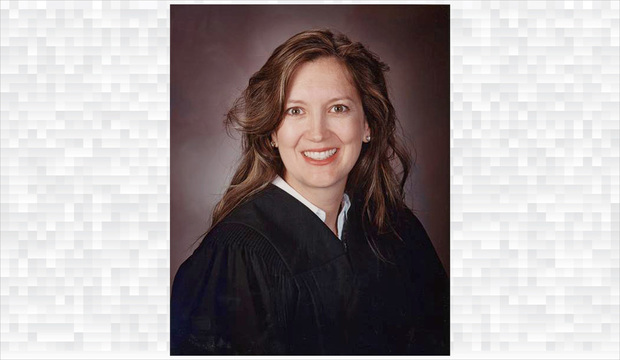Federal Circuit: PTO Judges Were Unconstitutionally Appointed
The court says it can fix the problem by interpreting the Patent Act as giving the PTO director greater authority to remove APJs from service. In the meantime, possibly hundreds of the board's final written decisions will have to be reheard by a new panel.
October 31, 2019 at 05:14 PM
4 minute read
 Judge Kimberly Ann Moore of the U.S. Court of Appeals for the Federal Circuit.
Judge Kimberly Ann Moore of the U.S. Court of Appeals for the Federal Circuit.
The administrative judges who hear challenges to patent validity at the U.S. Patent and Trademark Office are principal officers who should have been nominated by the president and confirmed by the U.S. Senate, the U.S. Court of Appeals for the Federal Circuit ruled Thursday.
Instead of throwing the 270 or so APJs off the Patent Trial and Appeal Board, the court said it will solve the problem by interpreting the Patent Act as providing the PTO director authority to remove APJs from service at will. "We conclude that severing the portion of the Patent Act restricting removal of the APJs is sufficient to render the APJs inferior officers and remedy the constitutional appointment problem," Judge Kimberly Moore wrote for a unanimous panel in Arthrex v. Smith & Nephew. Judges Jimmie Reyna and Raymond Chen concurred.
The decision—telegraphed in oral arguments earlier this month—will nevertheless cause a substantial disruption at the PTAB. Following the lead of a 2018 Supreme Court ruling on SEC judge appointments, the Federal Circuit ruled that any final written decisions from the PTAB that are pending on appeal, and where a party has raised the appointments issue, must be sent back to the PTAB for reconsideration by a different panel of judges. That reconsideration must include a new oral hearing, Moore wrote.
The Department of Justice and USPTO warned in supplemental briefs filed Tuesday that such a ruling could mean new hearings for "hundreds" of parties. The PTO had asked the court to limit any such relief to parties who had raised the appointments issue while before the PTAB, a much smaller subset. But Moore reasoned that it would have been futile for parties to raise the issue at the PTAB because the APJs would not have had the authority to declare their own appointments unconstitutional.
The upshot of Thursday's decision, if it's not reconsidered en banc or overturned by the Supreme Court, is an increased workload for PTAB judges in the short term and uncertain job security in the long term. "Never a dull moment," quipped Ropes & Gray partner Scott McKeown, who flagged the potential decision on Ropes' Patents Post Grant blog last week.
A spokesman for the PTO said the agency did not have immediate comment on what steps it might take in response to the decision. Another Federal Circuit panel is scheduled to hear arguments on the same issue in a separate case Monday. That could provide clues as to whether an en banc challenge might be worthwhile.
The Supreme Court ruled in Lucia v. SEC that administrative judges who aren't under close supervisory control of presidential appointees are principal officers who must be nominated by the president and confirmed by the Senate. As Moore put it Thursday, "The Appointments Clause ensures that the individuals in these positions of significant authority are accountable to elected Executive officials. … It further ensures that the President, and those directly responsible to him, does not delegate his ultimate responsibility and obligation to supervise the actions of the Executive Branch."
The PTO had argued that PTAB judges are inferior officers because the PTO director, a presidential appointee, exercises supervision in a variety of ways. The director sets rules and regulations for the patent validity challenges established by the 2011 America Invents Act. The director also has the power to appoint and remove judges from the three-judge panels that preside over those challenges, and can overturn decisions he disagrees with, the PTO argued.
Moore disagreed that the PTO director's supervisory powers extend that far. "The lack of any presidentially-appointed officer who can review, vacate, or correct decisions by the APJs combined with the limited removal power lead us to conclude … that these are principal officers," she wrote.
The least intrusive way to meet the constitutional obligation under Lucia is to interpret the Patent Act as giving the director complete control to remove PTAB judges from service, rather than only to promote "efficiency," as the law was previously interpreted.
"Like the D.C. Circuit in Intercollegiate, we believe severing the restriction on removal of APJs renders them inferior rather than principal officers," Moore wrote. "Although the Director still does not have independent authority to review decisions rendered by APJs, his provision of policy and regulation to guide the outcomes of those decisions, coupled with the power of removal by the Secretary without cause provides significant constraint on issued decisions."
This content has been archived. It is available through our partners, LexisNexis® and Bloomberg Law.
To view this content, please continue to their sites.
Not a Lexis Subscriber?
Subscribe Now
Not a Bloomberg Law Subscriber?
Subscribe Now
NOT FOR REPRINT
© 2025 ALM Global, LLC, All Rights Reserved. Request academic re-use from www.copyright.com. All other uses, submit a request to [email protected]. For more information visit Asset & Logo Licensing.
You Might Like
View All
US Judge Cannon Blocks DOJ From Releasing Final Report in Trump Documents Probe
3 minute read
Private Equity Giant KKR Refiles SDNY Countersuit in DOJ Premerger Filing Row
3 minute read
Three Akin Sports Lawyers Jump to Employment Firm Littler Mendelson
Trending Stories
- 1Pro Hac Vice in Georgia: Rule Change for Nonresident Attorneys
- 2The Benefits of E-Filing for Affordable, Effortless and Equal Access to Justice
- 3AI and Social Media Fakes: Are You Protecting Your Brand?
- 4A Primer on Using Third-Party Depositions To Prove Your Case at Trial
- 5‘Catholic Charities v. Wisconsin Labor and Industry Review Commission’: Another Consequence of 'Hobby Lobby'?
Who Got The Work
J. Brugh Lower of Gibbons has entered an appearance for industrial equipment supplier Devco Corporation in a pending trademark infringement lawsuit. The suit, accusing the defendant of selling knock-off Graco products, was filed Dec. 18 in New Jersey District Court by Rivkin Radler on behalf of Graco Inc. and Graco Minnesota. The case, assigned to U.S. District Judge Zahid N. Quraishi, is 3:24-cv-11294, Graco Inc. et al v. Devco Corporation.
Who Got The Work
Rebecca Maller-Stein and Kent A. Yalowitz of Arnold & Porter Kaye Scholer have entered their appearances for Hanaco Venture Capital and its executives, Lior Prosor and David Frankel, in a pending securities lawsuit. The action, filed on Dec. 24 in New York Southern District Court by Zell, Aron & Co. on behalf of Goldeneye Advisors, accuses the defendants of negligently and fraudulently managing the plaintiff's $1 million investment. The case, assigned to U.S. District Judge Vernon S. Broderick, is 1:24-cv-09918, Goldeneye Advisors, LLC v. Hanaco Venture Capital, Ltd. et al.
Who Got The Work
Attorneys from A&O Shearman has stepped in as defense counsel for Toronto-Dominion Bank and other defendants in a pending securities class action. The suit, filed Dec. 11 in New York Southern District Court by Bleichmar Fonti & Auld, accuses the defendants of concealing the bank's 'pervasive' deficiencies in regards to its compliance with the Bank Secrecy Act and the quality of its anti-money laundering controls. The case, assigned to U.S. District Judge Arun Subramanian, is 1:24-cv-09445, Gonzalez v. The Toronto-Dominion Bank et al.
Who Got The Work
Crown Castle International, a Pennsylvania company providing shared communications infrastructure, has turned to Luke D. Wolf of Gordon Rees Scully Mansukhani to fend off a pending breach-of-contract lawsuit. The court action, filed Nov. 25 in Michigan Eastern District Court by Hooper Hathaway PC on behalf of The Town Residences LLC, accuses Crown Castle of failing to transfer approximately $30,000 in utility payments from T-Mobile in breach of a roof-top lease and assignment agreement. The case, assigned to U.S. District Judge Susan K. Declercq, is 2:24-cv-13131, The Town Residences LLC v. T-Mobile US, Inc. et al.
Who Got The Work
Wilfred P. Coronato and Daniel M. Schwartz of McCarter & English have stepped in as defense counsel to Electrolux Home Products Inc. in a pending product liability lawsuit. The court action, filed Nov. 26 in New York Eastern District Court by Poulos Lopiccolo PC and Nagel Rice LLP on behalf of David Stern, alleges that the defendant's refrigerators’ drawers and shelving repeatedly break and fall apart within months after purchase. The case, assigned to U.S. District Judge Joan M. Azrack, is 2:24-cv-08204, Stern v. Electrolux Home Products, Inc.
Featured Firms
Law Offices of Gary Martin Hays & Associates, P.C.
(470) 294-1674
Law Offices of Mark E. Salomone
(857) 444-6468
Smith & Hassler
(713) 739-1250











